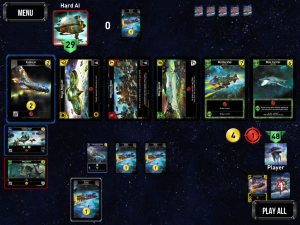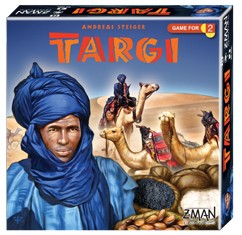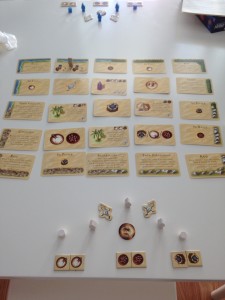Kero is a pure two-player game that is absolutely perfect if you like games with lots of dice-rolling – not the Monopoly sort, where you roll once and are stuck with it, but more like King of Tokyo and other games where you get to re-roll repeatedly until you get a result you like or you bust. There’s a lot of luck involved, and I’m not sure all of the elements here are strictly necessary, but there’s something very appealing in how Kero works the dice.
Kero’s theme is postapocalyptic, and each player has a truck full of kerosene that must be refilled from time to time. Players roll the dice to collect various resources and use them to collect cards worth points at game-end and that also give one-time or permanent benefits, and can place ‘recruits’ on the four territories on display to claim those for more game-end points. Your truck contains an hourglass with sand in it, and on your turn you flip it and may continue rolling your dice as long as you have sand (kerosene) left in your tank, or until your dice all show fire icons, after which those dice have ‘burned up’ and can’t be re-rolled. The other sides of the five basic white dice show various resources – metal, food, recruits, fuel, or bricks – and you may pay fuel to add any of the three bonus dice, which have bigger rewards on them.
When your fuel runs low, you can spend one jerrycan token to refuel – and your opponent gets to roll the dice. You flip your truck the other way, so the sand fills the visible portion of the truck’s tank, and your opponent rolls all eight dice, and rerolls every die until all eight show fire tokens, at which point the refueling stops and you set your truck on its wheels again. (If you get seven fire tokens, then you roll the eighth die a maximum of five times before you just give up.) So there’s randomness all over the game, but the designers – Prospero Hall, the same group behind the Villainous games – have mitigated that with the ability to re-roll, and additional tokens you can use to allow even further rerolls or that let you ignore fire symbols for a particular turn.
Once you’ve decided to stop rolling dice on your turn (assuming you didn’t run out of fuel, which would end your turn immediately), you can use the resources shown on your non-burned dice to buy things from the board. The most common choice will be to buy cards from the market, with cards granting you points at the end of the game and most cards giving you either a one-time bonus or a permanent (unique) bonus for the rest of the game. The permanent bonuses mostly appear in the first round of the game – there are three rounds, separated by ‘claim cards’ shuffled randomly into the main deck – and grant you powerful benefits like a specific resource in every turn for the rest of the game, or the ability to convert something into fuel. Each player also starts the game with two Tuarek tokens, which grant one-time abilities like the power to ignore fire icons on dice for a turn or to move explorers to different territories.
Those territories, of which there are twelve, appearing four at a time across the three rounds, are the other source of points for game-end, either flat bonuses or bonuses tied to the cards you’ve collected. Each player has seven explorer tokens they may place in each round, usually by combining a recruit icon and a metal icon from dice. When a claim card appears to end a round, players compare who has the most explorers on each territory; whoever has the most gets that card for the rest of the game, taking any immediate bonuses on it. (There’s a power you can gain that helps you win ties, which happen frequently.) This is one of the few clumsy mechanics in the game, because the rounds are short enough that territories often go to a player who placed a single explorer on them, and it’s nearly always more efficient to go claim an empty territory than to compete with your opponent for one where they’ve already placed a token.
Kero games run about a half-hour, as the game’s length is determined by how quickly you move through the card deck; any time a player finishes their turn with at least two fire icons showing on the dice, you also ‘burn’ the rightmost card in the market to keep things rolling (pun intended), so there’s no way to stall progress through the game. The mixture of controlled randomness through the dice and the light engine-building aspect of the cards with permanent benefits makes Kero better than a pure dice-rolling game, so there is some strategy involved, but it’s definitely a game of luck – perhaps one of making your own luck, but still one where the randomness of dice rolls has a lot to say about who wins. That makes it a good game to play with your kids, since the dice will help smooth out any gaps in your skill levels, and one I think we’ll keep on the shelves here, but not something I’d pick over my favorite two-player titles like Jaipur or 7 Wonders Duel.







